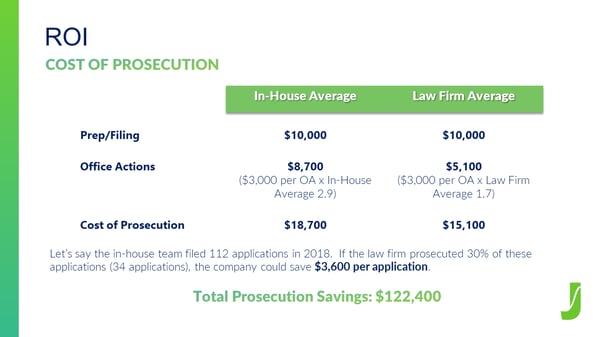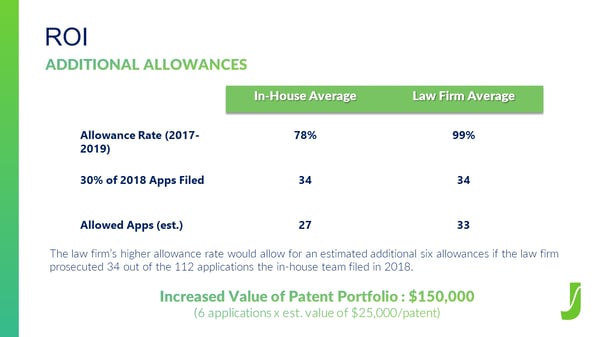As businesses feel the lingering stress from the COVID-19 pandemic, some are considering bringing patent prosecution in-house in order to cut costs. With clients continuing to mind their budgets, how can firms demonstrate the cost savings and ROI they bring to the table?
Maintaining existing work is imperative for firms right now – after all, maintaining (and growing) client relationships is often more cost-effective than trying to attract new business. To do this, firms must be able to clearly communicate the value of their services. And there’s no better way to do that than with data.
Here are two ways firms can use data to demonstrate cost savings and ROI to clients:
1. Use average office actions to show prosecution savings
It’s easy to make the argument that fewer office actions leads to a faster and less expensive prosecution. Tying that theory to hard data and translating it directly into cost savings can have a huge impact during client discussions.
Let’s say, for example, your firm is trying to convince your client not to move patent work in-house or to a competing firm. First, take into consideration the initial preparation and filing of an application. Here, we’re assuming that cost is $10,000, based on the AIPLA’s 2015 Report of the Economic Survey for an original, relatively complex application dealing with computers or electronics. We’re also assuming the cost for each office action is $3,000. Of course, you’ll have a better idea of costs for your specific firm, client, or technology.

This is where business intelligence data from Juristat comes in handy. Using analytics, your firm could easily compare your (superior!) OA track record to that of your client’s in-house team or even competing outside counsel.
After a few simple calculations, you can put a dollar amount on the value of your firm’s services. In this example, we see that by diverting 30% of the company’s applications to this law firm rather than prosecuting in-house, the potential prosecution savings are $122,400.
Translating office actions into a dollar value makes for a more clear cut argument when trying to keep or win more work from your client.
2. Show how allowance rate can increase portfolio value
Allowance rate isn’t the only way to quantify success, but it is an effective one – especially when it comes to showing the ROI of your firm’s services for a client.
Continuing the same example as above, we’re also able to show how a superior allowance rate could increase the value of the client’s patent portfolio.

Thanks to patent analytics, you’re able to compare your firm’s allowance rate with the client’s in-house team or competing outside counsel. You can then calculate how many additional allowed applications your firm could gain for the client.
In this example, we see that by diverting 30% of the company’s applications to this law firm rather than prosecuting in-house, the client is potentially increasing the value of their portfolio by $150,000 (assuming the value of a single patent is $25,000).
And remember, it pays to be a proactive legal partner
Though not a quantitative metric, now is the perfect time to position yourself as a proactive legal partner for your clients by providing guidance and uncovering new opportunities. This is a great time to:
- Run a SWOT analysis to identify new opportunities and potential threats
- Investigate infringement on issued art and suggest new licensing opportunities
- Review patents where they are paying maintenance fees and determine if it’s worth continuing
- Gather intelligence on major competitors, as well as emerging startups in your client’s market
Juristat analytics, as well as 102 Forward Citation Reports, are excellent resources to help you uncover these opportunities and position your firm as a dedicated partner for long-term business growth.
(gradient).webp)
.jpg)
